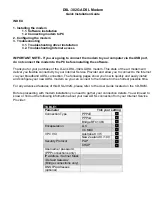
Q-Lite Satellite Modem Installation and Operating Handbook
7-9
adjusting the local power output of the satellite link in order to maintain the specified
remote-end Eb/No. Note that if the rain is falling at the local end of the link then the power
seen at the satellite will be unchanged. However, if the rain is falling at the remote end of
the link then the power seen by the satellite will increase, which if not controlled carefully
has the potential to affect other carriers or saturate the transponder. Carrier power must
be kept to the levels agreed with the satellite operator.
Remote Eb/No monitoring is performed by sending messages through the asynchronous
ESC channel (which is carried over the satellite multiplexed with the main data channel).
When using DVB-S2, which does not have an inherent ESC channel, Eb/No information
is injected, at a low rate with extremely low overhead, into the return channel.
An asynchronous ESC channel is available in Closed Network Plus ESC, IBS and IDR
modes. AUPC can share the ESC channel with other traffic, such as remote M&C
commands.
The modem can be set to simply monitor the remote Eb/No, or to maintain it at a
specified level. A deferred alarm can be set to activate if the remote Eb/No falls below a
user-set threshold.
A target Eb/No level has to be set along with a maximum transmit power level for the
local end. The transmit power is adjusted to keep the remote Eb/No at the target value. If
the satellite link is lost, then the transmit power can be frozen at its current level until the
link is restored, or it can be returned to its nominal value.
7.2.2 Configuring AUPC
To use the AUPC function, the following procedure should be followed:
1. Prior to switching on AUPC, configure the modems at both ends of the link and
ensure the satellite link is operating correctly.
2. Set the transmit power to achieve the remote Eb/No expected under clear-sky
conditions.
3. To receive an indication of when the remote Eb/No falls below a defined
threshold, set a target Eb/No minimum threshold (which will cause a backward
alarm to be generated under these conditions).
4. Set the AUPC mode to monitor the remote Eb/No in order to determine if it is
working correctly. If the remote-end Eb/No is not available on the
Status
screen
then the modems are not configured correctly.
5. Record the remote Eb/No under clear-sky conditions and then set the AUPC
mode to maintain the remote Eb/No.
6. Set a target Eb/No and set the maximum power level.
7. Review the remote Eb/No to confirm that it is being maintained correctly under
different atmospheric conditions. The web user interface remote Eb/No and power
graphs can be used to review AUPC performance.
















































